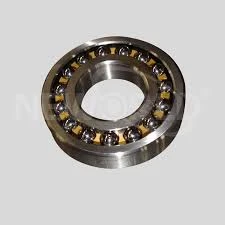
Sep . 14, 2024 12:45 Back to list
axial angular contact ball bearing
Understanding Axial Angular Contact Ball Bearings
Axial angular contact ball bearings are crucial components in various mechanical applications, particularly in industries that require high precision and reliability. These bearings are designed to accommodate both axial and radial loads, making them ideal for applications where space is limited and performance demands are high. This article will delve into the characteristics, benefits, and applications of axial angular contact ball bearings.
Design and Characteristics
Axial angular contact ball bearings consist of an inner ring, an outer ring, balls, and a cage. The unique design of these bearings allows them to support axial loads in one direction and provides the ability to handle high rotational speeds. The key feature of angular contact bearings is the contact angle at which the balls contact the raceway of the inner and outer rings. This angle influences how the load is distributed across the bearing and determines the bearing's overall capacity and stability.
The angle of contact can vary, with typical configurations ranging from 15 to 40 degrees. A larger contact angle results in greater axial load-carrying capacity but may reduce the radial load capacity. Consequently, selecting the right type of angular contact ball bearing for a specific application is crucial to ensure optimal performance.
Benefits
One of the primary advantages of axial angular contact ball bearings is their ability to handle combined loads. This is particularly beneficial in machinery where both radial and axial loads are present simultaneously. The construction of these bearings allows for efficient load distribution, reducing the risk of premature wear or failure.
axial angular contact ball bearing

Another significant benefit is the high-speed capability of these bearings. Due to their design and reduced friction, axial angular contact ball bearings can operate at higher speeds than conventional bearings. This quality is essential in applications such as electric motors, turbines, and high-speed machinery where performance and efficiency are critical.
Moreover, axial angular contact ball bearings are typically made from high-quality materials, including steel or ceramic, which enhances their durability and longevity. This robustness translates to lower maintenance costs and increased reliability in demanding conditions.
Applications
Axial angular contact ball bearings are widely used in various industries, including automotive, aerospace, and manufacturing. In the automotive sector, they are often found in gearboxes and wheel hubs, where they help in managing the stresses that arise during operation. In aerospace applications, these bearings are used in engines and landing gear systems, where reliability and precision are paramount.
In manufacturing, axial angular contact ball bearings play a vital role in machine tools, robotics, and conveyor systems, where both speed and precision are necessary. Additionally, their ability to sustain heavy loads makes them suitable for heavy machinery, such as cranes and construction equipment.
Conclusion
In summary, axial angular contact ball bearings are essential components that offer numerous advantages, including high load capacity, efficiency at high speeds, and versatility in various applications. Understanding the mechanics and benefits of these bearings is vital for engineers and technicians who design and maintain equipment in industries reliant on precision and reliability. As technology continues to advance, the design and applications of axial angular contact ball bearings are likely to evolve, further enhancing their importance in modern machinery and equipment.
Latest news
-
Common Failures in Thrust Ball Bearings and Solutions
NewsAug.22,2025
-
How Tapered Roller Bearings Can Take Shock Loads
NewsAug.22,2025
-
Angular Bearings in High-Precision Spindles
NewsAug.22,2025
-
The Impact of Misalignment on Cylindrical Roller Bearing Performance
NewsAug.22,2025
-
The Role of Cage Design in Deep Groove Ball Bearing Durability
NewsAug.22,2025
-
The Impact of Material Quality on Machinery Bearings’ Lifespan
NewsAug.22,2025
